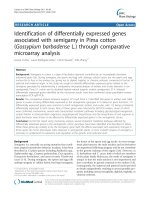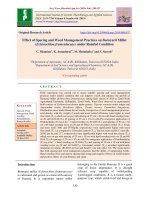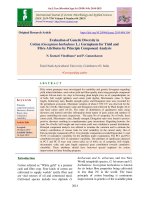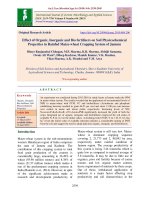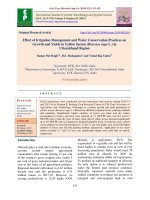Effect of in-situ moisture conservation practices on soil moisture content of rainfed Bt cotton (Gossypium hirsutum L.)
Bạn đang xem bản rút gọn của tài liệu. Xem và tải ngay bản đầy đủ của tài liệu tại đây (317.72 KB, 7 trang )
Int.J.Curr.Microbiol.App.Sci (2018) 7(10): 2832-2838
International Journal of Current Microbiology and Applied Sciences
ISSN: 2319-7706 Volume 7 Number 10 (2018)
Journal homepage:
Original Research Article
/>
Effect of In-Situ Moisture Conservation Practices on Soil Moisture Content
of Rainfed Bt Cotton (Gossypium hirsutum L.)
S. Ganapathi*, S. Bharathi, M. Sree Rekha and K. Jayalalitha
Department of Agronomy, Agricultural College, Bapatla, India
*Corresponding author
ABSTRACT
Keywords
Recommended dose of
fertilizer, in- situ, Soil
moisture conservation
and Foliar nutrition
Article Info
Accepted:
20 September 2018
Available Online:
10 October 2018
A field experiment conducted on clay soil of Regional Agricultural Research Station, Lam,
Guntur, during kharif 2017-18. The treatments were T3 - 100 % RDF (120:60:60) +
opening furrow for every row during last intercultural operation, T4 - 125% RDF
(150:75:75) + opening furrow for every row during last intercultural operation, T7 - 100%
RDF (120:60:60)+ opening furrow for every row during last intercultural operation + foliar
nutrition with 2% KNO3 at square formation, flowering and boll development and T8 125% RDF (150:75:75)+ opening furrow for every row during last intercultural operation
+ Foliar nutrition with 2% KNO3 at square formation, flowering and boll development.
Found to be more soil moisture conserve these treatments are soil moisture percentage
decreased gradually from 60 DAS to harvest.
Introduction
Cotton “ white gold” is an important fibre as
well as cash crop of India. In India, Bt cotton
is grown in an area of 12.2 m. ha with an
annual production of 377 lakh bales and a
productivity of 524 kg lint ha-1. In the state of
Andhra Pradesh, Bt cotton occupies an area of
5.44 lakh hectares with an annual production
of 22 lakh bales and productivity of 688 kg
lint ha-1 (AICCIP, Annual Report, 2017-2018).
In Andhra Pradesh, Bt Cotton is mainly grown
under rainfed condition. The vagaries of
monsoon have maligned even in the assured
rainfall areas in the recent years. Cotton, being
a long duration crop, needs a fairly sufficient
soil moisture to sustain the growth at later
stages of reproductive phase. In this backdrop,
efficient utilization of rain water plays a
pivotal role which can be achieved by various
agronomic management practices, of which
in-situ moisture conservation is the most
important one that reduce the runoff there by
storing more soil moisture ( Asewar et al.,
2008).
In-situ rain water conservation practice like
opening furrows in between rows, often help
in conserving soil moisture and ultimately
enhance water use efficiency as well. The cost
effective technologies for efficient utilization
of rain water management as in - situ moisture
conservation comprising the opening of
furrow, may prove vital in enhancing and
stabilizing the yield (Gokhale et al., 2011).
2832
Int.J.Curr.Microbiol.App.Sci (2018) 7(10): 2832-2838
The significance of in-situ soil moisture
conservation measures is to conserve
maximum possible rainwater at a place where
it falls and make effective efficient use of it.
The practices of opening furrow in between
row of crop is also beneficial for improving
the drainage system in field during the high
rainfall period and for decomposing the added
biomass later on. Ridge may serve as microwatershed accumulating water in furrow.
Practices of making ridge by opening furrow
may have an advantage in concentration of
more rain water on the bed which enrich soil
moisture content (Gidda and Morey, 1981)
and the yield levels could be increased
(Redder et al., 1991).
nutrition with 2% KNO3 at square formation,
flowering and boll development. Phosphorus
was applied as basal through SSP as per the
treatments. Nitrogen and potassium was
applied through urea and Murete of potash 1/3
at basal, 1/3 at 60 DAS and 1/3 at square
initiation stage. The hirsutum Bt hybrid
(jadoo) was sown at spacing of 105 cm x 60
cm on 15 july, 2017-18. The data on plant
height, boll weight and number of bolls per
plant were recorded from randomly selected
five plants from each plot and seed cotton
yield was recorded on /plot basis. other
agronomic practices and plant protection
measures were followed as per
recommendation.
Materials and Methods
Results and Discussion
A field experiment was conducted during
kharif 2017-18 at
Regional Agricultural
Research Station, Lam, Guntur, the soil of the
experimental field was clay in texture, neutral
in reaction (7.45), low in total nitrogen and
high in available phosphorus and potassium.
The experiment was laid out in a randomized
block design with three replications and eight
treatments. The allocated treatments were T1 100 % RDF ( 120:60:60) NPK kg ha-,1 T2 125% RDF (150:75:75) NPK kg ha-1, T3 - 100
% RDF ( 120:60:60) + opening furrow for
every row during last intercultural operation,
T4 - 125% RDF (150:75:75) + opening furrow
for every row during last intercultural
operation, T5 - 100% RDF ( 120:60:60) +
Foliar nutrition with 2% KNO3 at square
formation, flowering and boll development, T6
- 125% RDF (150:75:75) + Foliar nutrition
with 2% KNO3 at square formation, flowering
and boll development, T7 - 100% RDF
(120:60:60)+ opening furrow for every row
during last intercultural operation + foliar
nutrition with 2% KNO3 at square formation,
flowering and boll development and T8 - 125%
RDF ( 150:75:75)+ opening furrow for every
row during last intercultural operation + Foliar
The soil moisture (%) at different crop growth
stages of cotton was recorded (Table 1). The
soil moisture percentage decreased gradually
from 60 DAS to 120 DAS. In the study, the
nutrient
management
and
moisture
conservation practices influenced the soil
moisture percentage Fig. 4.2 and Table 4.5. A
total rainfall of (466 mm) was received during
the crop growing season in 36 rainy days. The
moisture conservation treatments of opening
the furrows were imposed during the last
intercultural operation and the data on soil
moisture was recorded at 60, 90 and 120 DAS
revealed that maximum soil moisture (%) was
recorded in 125% RDF (150:75:75) +opening
furrow for every row during last intercultural
operation + foliar nutrition with 2% KNO3 at
square formation, flowering and boll
development, 100% RDF (120:60:60)
+opening furrow for every row during last
intercultural operation + foliar nutrition with
2% KNO3 at square formation, flowering and
boll development, 125% RDF (150:75:75)
+opening furrow for every row during last
intercultural operation and 100% RDF
(120:60:60) + opening furrow for every row
during last intercultural operation and the
2833
Int.J.Curr.Microbiol.App.Sci (2018) 7(10): 2832-2838
lowest soil moisture (%) was recorded with
100% RDF (120:60:60). The availability of
more soil moisture in these treatments might
be due to practice of opening furrows which
acts as drainage during heavy rains and serves
for in situ infiltration and retention of moisture
during the dry spells. These results are in
conformity with Narayana et al., ( 2011),
Tayade and Meshram ( 2013) and Paslawar
and Deotalu (2015). At harvest the maximum
drymatter accumulation ( 11915 kg ha-1)
(Table 1) was recorded with 125% RDF
(150:75:75) + opening furrow for every row
during last intercultural operation + foliar
nutrition with 2% KNO3 at square formation,
flowering and boll development. The lowest
drymatter accumulation (9391 kg ha-1) was
recorded at 100% RDF (120:60:60) NPK kg
ha-1. The increased drymatter accumulation
with 125% RDF might be due to the fact that
increased fertilization made the plants more
efficient in photosynthetic activity by
enhancing the carbohydrate metabolism and
hence resulted in increased drymatter
accumulation. Squaring, blooming and boll
development are the stages when cotton
requires higher nutrition and augment of
nutrient supply through foliar application at
such critical stages help in increased growth
parameters especially drymatter accumulation,
which might be due to adequate supply of
nutrients with foliar application (Rajendran et
al., 2011; Devraj et al., 2011; Sandeep et al.,
2015 and Santhosh et al., 2016).
At harvest, the maximum number of
sympodial branches per plant (Table 1) (23.2)
were recorded with application of 125% RDF
(150:75:75) + opening furrow for every row
during last intercultural operation + foliar
nutrition with 2% KNO3 at square formation,
flowering, and boll development. The lowest
sympodial branches (16.8) per plant was
recorded with 100% RDF (120:60:60) NPK kg
ha-1. Similar trend in number of sympodial
branches was recorded at 60, 90, and 120 DAS
as well. The more number of sympodial
branches per plant with opening of furrows at
every row might be due to increase the soil
moisture availability to crops as well as
increase in the nutrient use efficiency. Similar
results were reported made by Santhosh et al.,
(2016), Narayana et al., (2011) and Rajendran
et al., (2011).
The maximum numbers of bolls per plant
(78.1) were recorded (Table 1) with 125%
RDF (150:75:75) +opening furrow for every
row during last intercultural operation + foliar
nutrition with 2% KNO3 at square formation,
flowering and boll development and lowest
recorded with 100% RDF (120:60:60) NPK kg
ha-1(56.7 bolls plant-1 and 63.7 bolls m2). The
increase in boll number per plant was obtained
with opening furrow for every row during last
intercultural operation might be due to better
soil moisture retention that might have helped
for better utilization of nitrogen, phosphorus
and potassium fertilizer applied ( Keshava et
al., 2013; Saravanan et al., 2012 and Nehra
and Yadav, 2013).
Significantly affected by soil moisture
conservation practices Maximum seed cotton
yield (3411 kg ha-1) was recorded with (Table
1) 125% RDF (150:75:75) +opening furrow
for every row during last intercultural
operation + foliar nutrition with 2% KNO3 at
square formation, flowering and boll
development and lowest seed cotton yield
(2285 kg ha-1) was recorded with RDF
(120:60:60) NPK kg ha -1 and stalk yield of
cotton as influenced by nutrient management
and soil moisture conservation practices Fig.
4.4 and Table 4.9 presented maximum stalk
yield was (5877 kg ha-1) recorded with 125%
RDF (150:75:75)+opening furrow for every
row during last intercultural operation + foliar
nutrition with 2% KNO3 at square formation,
flowering and boll development and Lowest
stalk yield was (5282 kg ha-1) was recorded
with RDF (120:60:60).
2834
Int.J.Curr.Microbiol.App.Sci (2018) 7(10): 2832-2838
Table.1 Effect of in-situ soil moisture conservation practices on growth parameters, yield attributes and yield of Bt cotton
Treatments
Soil Moisture (%)
Dry
matter
accumu
lation
(kg ha-1)
Sympodi
al
branches
plant-1
Number
of
bolls
plant-1
Seed
cotton
yield
(kg ha-1)
Stalk
yield
(kg
ha-1)
GOT
(%)
T1- 100 % RDF (120:60:60) NPK
60
DAS
9.4
90
DAS
8.6
At
Harvest
4.3
At
Harvest
9391
At
Harvest
16.8
At
Harvest
56.7
2285
5282
33.3
T2- 125% RDF(150:75:75) NPK
10.0
9.4
4.1
9788
19.4
64.0
2460
5505
33.2
T3- T1+ Opening furrow for every row during last
intercultural operation.
T4- T2+ Opening furrow for every row during last
intercultural operation.
T5- T1+ Foliar nutrition with 2% KNO3 at square
formation, flowering, and boll development.
T6- T2+ Foliar nutrition with 2% KNO3 at square
formation, flowering, and boll development.
T7- T3+ Foliar nutrition with 2% KNO3 at square
formation, flowering, and boll development.
T8- T4+ Foliar nutrition with 2% KNO3 at square
formation, flowering, and boll development.
S.Em ±
14.1
13.6
8.2
9655
18.2
59.6
2519
5431
33.9
14.3
13.9
8.3
10053
20.4
70.8
2947
5654
33.8
10.2
8.8
5.1
9920
19.6
68.4
2831
5580
33.3
10.0
9.7
4.6
11283
21.4
74.1
3266
5803
33.1
14.1
13.4
8.3
10650
20.8
71.3
3177
5712
33.5
14.8
13.9
8.4
11915
23.2
78.1
3411
5877
33.1
0.3
1.0
0.4
682.3
0.6
4.8
96.2
131.5
2.2
CD (P=0.05)
1.1
3.1
1.5
1964.7
2.4
7.8
292.0
394.6
NS
CV (%)
5.3
15.8
13.3
11.4
5.2
12.3
5.8
12.1
11.5
2835
Int.J.Curr.Microbiol.App.Sci (2018) 7(10): 2832-2838
Table.2 Economics of different treatments of Bt cotton as influenced by nutrient management and moisture conservation practices
Treatments
Seed
cotton
yield (kg
ha-1)
Gross
Returns
(Rs. ha-1)
Cost of
cultivation
(Rs. ha-1)
Net
Returns
(Rs. ha-1)
B:C
Ratio
T1- 100 % RDF (120:60:60) NPK
2285
99401
42231
57169
1.35
T2- 125% RDF(150:75:75) NPK
2460
107029
46590
60439
1.30
T3- T1+ Opening furrow for every row during last intercultural operation.
2519
109613
44809
64803
1.44
T4- T2+ Opening furrow for every row during last intercultural operation.
2947
128219
51000
77219
1.51
T5- T1+ Foliar nutrition with 2% KNO3 at square formation, flowering, and boll
development.
2831
123170
47103
76067
1.61
T6- T2+ Foliar nutrition with 2% KNO3 at square formation, flowering, and boll
development.
3266
142086
52017
90069
1.73
T7- T3+ Foliar nutrition with 2% KNO3 at square formation, flowering, and boll
development.
3177
138202
51368
86835
1.69
T8- T4+ Foliar nutrition with 2% KNO3 at square formation, flowering, and boll
development.
3411
148380
53174
95205
1.79
S.Em ±
96.2
4188.41
-
4188.41
0.084
CD (P=0.05)
292.0
12704.3
-
12704.3
0.25
5.8
5.8
-
9.5
9.3
CV (%)
2836
Int.J.Curr.Microbiol.App.Sci (2018) 7(10): 2832-2838
NPK kg ha -1 the increase in stalk yield might
be due to favorable effect of macro nutrients
on cell elongation, cell wall thickening, stem
and leaf thickness and more of leaf and stem
weight. Similar results were observed by
Halemani et al., (2004) and Rajendran et al.,
(2011) and Sandeep et al., (2015).
The higher gross returns, net income and
benefit cost ratio were obtained (Table 2) with
125% RDF (150:75:75) +opening furrow for
every row during last intercultural operation +
Foliar nutrition with 2% KNO3 at square
formation, flowering, and boll development
and was similar with 125% RDF (150:75:75)
+ foliar nutrition with 2% KNO3 at square
formation, flowering and boll development
followed by 100% RDF (120:60:60) +
opening furrow for every row during last
intercultural operation + foliar nutrition with
2% KNO3 at square formation, flowering, and
boll development and125% RDF(150:75:75)+
opening furrow for every row during last
intercultural operation and boll development.
Which, might be due to higher seed cotton
yield obtained per unit area. Similar result
obtained by Narayana et al., (2011) and
Santhosh et al., (2016).
References
AICCIP. 2017-18. All India Coordinated
Cotton Improvement Project – Annual
report. Coimbatore, Tamil Nadu.
Asewar, B.V., Jadhav, A.S and Khan, Y.A.
2008. Effect of in situ water
management and intercropping systems
on yield of rainfed cotton. Journal of
Cotton Research and Development. 22
(2): 173-175.
Devraj, Bhattoo, M.S., Duhan, B.S., Kumari,
P and Jain, P.P. 2011. Effect of crop
geometry and fertilizer levels on seed
cotton yield and nutrient uptake of Bt
cotton under irrigated conditions.
Journal of Cotton Research and
Development. 25 (2): 176-180.
Gidda, V.R and Morey, D.K. 1981. Effect of
tillage practices and antitranspirant on
relative water content, leaf water
potential and yield of rainfed cotton
(SRT-I). Journal
of
Maharashtra
Agricultural Universities (India).
Gokhale, D.N., Shinde, V.S., Gadade, G.D.,
Sawargaonkar, G.L and Zade, K.K.
2011. Sustaining rainfed Bt cotton
(Gossypium hirsutum L.) productivity
through moisture conservation and
integrated
nutrient
management
techniques. Journal of Cotton Research
and Development. 25 (2): 197-201.
Helemani, H.L., Hallikeri, S.S., Antravali,
M.B. and Nandagavi, R.A. 2002.
Studies on dry sowing and rain water
harvesting in rainfed cotton. Journal of
Indian Society and Cotton Improvement.
27: 94-99.
Keshava, C.S., Goroji, P.T., Doreswamy, C
and Naresh, N.T. 2014. Assessment of
foliar spray of potassium nitrate on
growth and yield of cotton. Karnataka
Journal of Agricultural Sciences. 26 (2).
Narayana, E., Aparna, D and Mridula, G.
2011. Response of
Bt cotton
(Gossypium hirsutum L) for integrated
rain water and nutrient management.
Journal of Cotton Research and
Development. 25 (1): 68-70.
Nehra, P.L and Yadav, P.S. 2013. Effect of
moisture conservation and nutrient
management for improvement in
productivity and fibre quality of cotton.
Journal of Cotton Research and
Development. 27 (1): 70-72.
Paslawar, A. N and Deotalu, A. S. 2015.
Impact of soil moisture conservation
practices and nutrient management
under high density planting system of
cotton. The International Journal of
Engineering and Science. 4 (9): 34-36.
2837
Int.J.Curr.Microbiol.App.Sci (2018) 7(10): 2832-2838
Rajendran, K., Mohamed, M.A and
Vaiyapuri, K. 2011. Influence on
growth, yield attributes and yield of Bt
cotton by soil and foliar application of
nutrients. Madras
Agricultural
Journal. 98 (1/3): 67-68.
Redder, G.D., Itnal, C.J., Surkod, V.S and
Baridar, S.N. 1991. Compartment
bunding an effective in- situ moisture
conservation practice on medium deep
block soil. Indian Journal of Soil
Conservation. 19: 1-5.
Sandeep, R., Mehta, A.K., Thakral, S.K and
Mahesh, K. 2015. Effect of nitrogen and
phosphorus levels on growth, yield
attributes and yield of Bt cotton. Journal
of
Cotton
Research
and
Development. 29 (1): 76-78.
Santhosh, U.N., Satyanarayan, R., Biradar,
S.A., Desai, B.K., Halepyati, A.S and
Koppalkar, B.G. 2016. Response of soil
and foliar nutrition on Bt cotton
(Gossypium hirsutum L.) quality, yield
parameters and economics under
irrigation. Journal of Cotton Research
and Development. 30 (2): 205-209.
Saravanan, M., Venkitaswamy, R and
Rajendran, K. 2012. Influence of foliar
nutrition on seed cotton yield and
quality
of
Bt
cotton. Madras
Agricultural Journal. 99 (4/6): 332-334.
Tayade, A. S and Meshram, M. K. 2013.
Impact of dry sowing and in-situ
moisture conservation on productivity
of rainfed cotton. Journal of Cotton
Research and Development. 27 (1): 6669.
How to cite this article:
Ganapathi, S., S. Bharathi, M. Sree Rekha and Jayalalitha, K. 2018. Effect of In-Situ Moisture
Conservation Practices on Soil Moisture Content of Rainfed Bt Cotton (Gossypium hirsutum
L.). Int.J.Curr.Microbiol.App.Sci. 7(10): 2832-2838.
doi: />
2838

